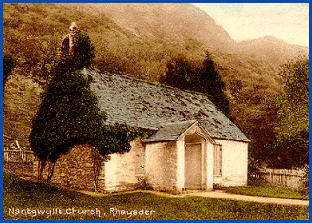The Old Mother: Welsh Disestablishment 2
 By the middle of the nineteenth century, the established church in Wales (henceforth Church in Wales), no longer represented the majority of Christians in Wales.
By the middle of the nineteenth century, the established church in Wales (henceforth Church in Wales), no longer represented the majority of Christians in Wales.The leadership of the Church in Wales, or what had passed for it in the Eighteenth Centur,yhad rejected the Calvinistic Methodists. The fathers of Methodism were either refused ordination (Howell Harris), or refused preferment (Daniel Rowland, Williams Pantycelyn), and by 1801, the Calvinistic Methodist societies had been forced to organise as an independent church. In addition, the church leadership, in the form of the bishops, were English, and possessed no sympathy with the aspirations of Wales as a nation. Put simply, the Church in Wales could not have done a better job of appearing to be an English body if they'd tried.
The religious census of 1851 established that, in Wales, the Anglican Church, ‘by law established’ was no longer the church of the majority. Eighty percent of Welsh churchgoers preferred to draw their water from a different spring, and although it could be argued that this figure had been exaggerated, it remained clear that the established church only catered for a minority of the population.[1] While the Church in Wales had been losing members to nonconformity for at least a century, calls for disestablishment had at first been muted. The first generation of leaders of the independent Calvinistic Methodist Church were more concerned with spiritual than temporal matters.[2] Although the older dissenting denominations, such as the Independents and the Baptists had historically been committed to the separation of Church and State,[3] it was only after the Calvinistic Methodists abandoned their conservative political stance following the death of John Elias in 1841 that the campaign for disestablishment in Wales really gathered speed.[4]
Next time, we shall look at the arguments of Henry Richard, one of the earliest proponents of Disestablishment.
[1] Kenneth Morgan, Freedom, or Sacrilege? (Penarth, 1966) p.4; P.M.H Bell, Disestablishment in Ireland and Wales (London, 1969), p.17; R. Tudur Jones, Congregationalism in Wales (Cardiff, 2004), p.207.
[2]In the 1834 Bala Association of the Calvinistic Methodist Church, a resolution was passed disassociating the Calvinistic Methodists from the agitation for disestablishment (Jones, Congregationalism, p.163; Kenneth Morgan, Freedom, p.7).
[3] Kenneth Morgan, Freedom, p.6. The independent minister Samuel Roberts (1800-1885) spent much of his time after his ordination in 1827 in airing nonconformist grievances. Methodist leader, John Elias was careful to disassociate himself from ‘radical’ sentiments in the eyes of churchmen (Jones, Congregationalism, pp.161-4).
[4] Edward Morgan, John Elias: Life, Letters and Essays (1844 and 1847, reprinted Edinburgh, 1973), pp.181; Jones, Congregationalism, p.167.
Labels: Welsh Disestablishment

0 Comments:
Post a Comment
<< Home